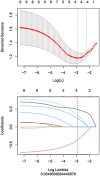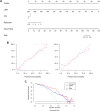Preoperative prediction of early recurrence in patients with BRAF mutant colorectal cancer using a intergrated nomogram
- PMID: 39455810
- PMCID: PMC11512039
- DOI: 10.1038/s41598-024-77256-2
Preoperative prediction of early recurrence in patients with BRAF mutant colorectal cancer using a intergrated nomogram
Abstract
Objective To explore the predictive value of radiomics nomogram combining with CT radiomics features and clinical features for postoperative early recurrence in patients with BRAF-mutant colorectal cancer. Methods A total of 220 patients with surgically and pathologically confirmed BRAF-mutant colorectal cancer from 2 institutions were retrospectively included. All patients from institution 1 were randomized at a 7:3 ratio into a training cohort (n = 108) and an internal validation cohort (n = 45), and patients from institution 2 were used as an external validation cohort (n = 67). The association between the radiomics features and early recurrence was assessed in the training cohort and verified in the validation cohort. Furthermore, the performance of the radiomics nomogram was evaluated by combining the rad-score and clinical risk factors. The predictive performance was evaluated by receiver operating characteristic curve analysis, calibration curve analysis, and decision curve analysis. Results The dierenees in the Lymphocyte/monocyte ratio (LMR) and Peripheral nerve infiltration (PNI) were statistically significant between the early recurrence in BRAF-mutant colorectal cancer groups and the early non-recurrence in BRAF-mutant colorectal cancer groups (P < 0.05); The two groups showed no significant differenee in clinical parameters including age, sex, and biochemistry serum markers (P > 0.05). Comparing with the pure radiomics or clinical data, combined models can be seen that the addition of LMR and PNI further improveed the predictive efficiency of the model. The rad-score based on LR, generated by 4 selected radiomics features, demonstrated a favorable ability to predict early recurrence in both the training (AUC 0.81), internal validation (AUC 0.73), external validation (AUC 0.63) cohorts. Subsequently, integrating two independent predictors into a nomogram exhibited more favorable discriminatory performance, with the AUC improved to 0.88 and 0.81 in both cohorts. Conclusions The proposed CT-based radiomics signature is associated with early recurrence among the patients with BRAF-mutant colorectal cancer. The present study also proposes a combined model can potentially be applied in the individual preoperative prediction of early recurrence in patients with BRAF-mutant colorectal cancer. Advances in knowledge CT-based radiomics showed satisfactory diagnostic significance for early recurrence in patients with BRAF-mutant colorectal cancer. Key baseline clinical characteristics were associated with early recurrence in patients with BRAF-mutant colorectal cancer. The combined model may be applied in the individual preoperative prediction of early recurrence in patients with BRAF-mutant colorectal cancer.
Keywords: BRAF-mutant colorectal cancer; Computed tomography; Early recurrence; Radiomics.
© 2024. The Author(s).
Conflict of interest statement
The authors of this manuscript declare no relationships with any companies, whose products or services may be related to the subject matter of the article. Statistics and biometry TaoHu Zhou, the co-author of this manuscript, has significant statistical expertise.
Figures








References
-
- Eurboonyanun, K. et al. Imaging predictors of BRAF mutation in colorectal cancer [J]. Abdom Radiol (NY), 45(8): 2336–2344., Chemotherapy with preoperative radiotherapy in rectal cancer [J]. N Engl J Med, 2006, 355(11): 1114–1123. (2020). - PubMed
-
- Qin, S. et al. Efficacy and tolerability of first-line cetuximab plus leucovorin, fluorouracil, and oxaliplatin (FOL-FOX-4) versus FOLFOX-4 in patients with RAS wild-type metaatatic colorectal cancer: the open-label, radomized, phase III TAILOR trial [J]. J. Clin. Oncol.36 (30), 3031–3039 (2018). - PMC - PubMed
MeSH terms
Substances
LinkOut - more resources
Full Text Sources
Medical
Research Materials

